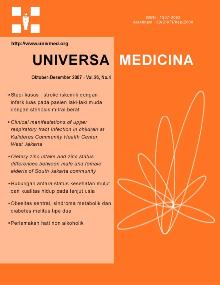Obesitas sentral, sindroma metabolik dan diabetes melitus tipe dua
Main Article Content
Abstract
Article Details
Issue
Section
The journal allows the authors to hold the copyright without restrictions and allow the authors to retain publishing rights without restrictions.
How to Cite
References
Seidel JC, Rissanen AM. Time trends in world wide prevalence of obesity. In: Bray GA, Bouchard C, James WPT, eds. Handbook of obesity. New York, NY: Marcel Dekker, 1998: 79-91.
World Health Organization. Obesity: Preventing and managing the global epidemic. Report of a WHO consultation. WHO technical report series, 894. Geneva, Switzerland: World Health Organization, 2000.
Hill JO, Wyatt HR, Reed GW, Peter JC. Obesity and the environment: Where do we go from here? Science 2003; 299: 853-5.
Pi-Sunyer X. A clinical view of the obesity problem. Science 2003; 299: 859-60.
International Diabetes Federation. The IDF consensus worldwide definition of the metabolic syndrome. Available at: http://www.idf.org. Accessed Mei 2, 2007.
Wannamethee SG, Shaper AG, Morris RW, Whincup PH. Measures of adiposity in the identification of metabolic abnormalities in elderly men. Am J Clin Nutr 2005; 81: 1313-21.
Reaven GM. Role of insulin resistance in human disease. Diabetes 1988; 37: 1595-607.
Kaplan NM. The deadly quartet. Upper body obesity, glucose intolerance, hypertrigliseridemia, and hypertension. Arch Intern Med 1989; 149: 1514-20.
Alberti KGMM, Zimmet PZ. For the WHO consultation, definition, diagnosis and classification of diabetes mellitus and its complications: Part 1. Diagnosis and classification of diabetes melitus. Provision report of a WHO consultation. Diabet Med 1998; 15: 539-53.
Sukmawati IR, Harijanto T. Optimal cut off value for obesity: Using anthropometric indices to predict atherogenic dyslipidemia in Indonesia population. In 3rd National Obesity Symposium (NOS III) 2004. p. 87-8.
Woods SC, Seeley RJ. Understanding the physiolofy of obesity: review of recent development in obesitasity research. Int J Obesitas Relat Metab Disord 2002; 26: suppl 4: S8-10.
Kelner K, Helmuth L. Obesity-What is to be done. Science 2003; 299: 845.
Hannon TS, Rao G, Arslanian SA. Childhood obesity and type 2 diabetes mellitus. Pediatrics 2005; 116: 473-80.
Hofbauer KG. Molecular pathways to obesity. Int J Obesitas 2002; 26: 18-27.
Fruhbeck G, Ambrosi JG, Muruzabal FJ, Burrell MA. The adipocyte: a model for intergration of encdocrine and metabolic signaling in energy metabolism regulation. Am J Physiol Endocrinol Metab 2001; 280: 827-47.
Grey A. The reductive hotspot hypothesis: An update. Arch Biochem Biophys 2000; 373: 295-301.
Faraci FM, Didion SP. Vascular protection superoxide dismutase isoforms in the vessel wall. Arterioscler Thromb Vasc Biol 2004; 24: 1367-73.
Watson KE, Harmel ALP, Matson G. Atherosclerosis in type 2 diabetes mellitus: The role of insulin resistance. J Cardiovasc Pharmacol Therapeut 2003; 8: 253-60.
Garg A. Regional adiposity and insulin resistance. J Clin Endocrinol Metab 2004; 89: 4206-10.
Gastaldelli A, Miyazaki Y, Pettiti M, Buzzigoli E, Mahankali S, Ferrannini E, et al. Separate contribution of diabetes, total fat mass, and fat topography to glucose production, gluconeogenesis, and glycogenolysis. J Clin Endocrinol Metab 2004; 89: 3914-21.
Zhu SK, Wang ZM, Shen W, Heymsfield SB, Heshka S. Percentage body fat ranges associated with metabolic syndrome risk: results based on the third national health and nutrition examination survey. Am J Clin Nutr 2003; 78: 228-35.


